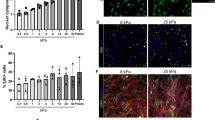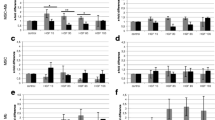Abstract
Myoblasts are precursor muscle cells that lie nascent to mature skeletal muscle. Once muscle is damaged, these cells migrate, fuse, and regenerate the muscle tissue. It is known that skeletal muscle can partially regenerate in vivo after muscle tissue damage. However, this regeneration does not always occur, especially in more severe injuries. Cellular therapy using tissue-engineering approaches has been shown to improve organ repair and function. To exploit potential benefits of using cell therapy as an avenue for skeletal muscle repair, it is important to understand the cellular dynamics underlying skeletal myocyte formation and growth. Cardiac fibroblasts have been shown to have a major influence on cardiomyocyte function, repair, and overall spatial distribution. However, little is known regarding fibroblasts’ role on skeletal myocyte function. In this study, we utilized a reconfigurable co-culture device to understand the contact and paracrine effects of fibroblasts on skeletal myocyte alignment and differentiation using murine myoblast and fibroblast cell lines. We demonstrate that myotube alignment is increased by direct contact with fibroblasts, while myotube differentiation is reduced both in the gap and contact configurations with fibroblasts after 6 days of co-culture. Furthermore, neutralizing antibodies to FGF-2 can block these effects of fibroblasts on myotube differentiation and alignment. Finally, bi-directional signaling is critical to the observed myoblast-fibroblast interactions, since conditioned media could not reproduce the same effects observed in the gap configuration. These findings could have direct implications on cell therapies for repairing skeletal muscle, which have only utilized skeletal myoblasts or stem cell populations alone.







Similar content being viewed by others

References
P. Bajaj, B. Reddy, Jr., et al., Integr Biol (Camb). 3, 9 (2011)
T.A. Baudino, W. Carver, et al., Am J Physiol Heart Circ Physiol. 291, 3 (2006)
J.R. Beauchamp, J.E. Morgan, et al., J Cell Biol. 144, 6 (1999)
C.F. Buchanan, C. S. Szot, et al., J Cell Biochem. (2011)
D.R. Cook, M. E. Doumit, et al., J Cell Physiol. 157, 2 (1993)
S.T. Cooper, A.L. Maxwell, et al., Cell Motil Cytoskeleton. 58, 3 (2004)
N.K. Decker, S.S. Abdelmoneim, et al., Am J Pathol. 173, 4 (2008)
Y. Fan, M. Maley, et al., Muscle Nerve. 19, 7 (1996)
H. Flanagan-Steet, K. Hannon, et al., Dev Biol. 218, 1 (2000)
M. Fortier, F. Comunale, et al., Cell Death Differ. 15, 8 (2008)
M.D. Grounds, Z. Yablonka-Reuveni, Mol Cell Biol Hum Dis Ser. 3, (1993)
K. Hannon, A.J. Kudla, et al., J Cell Biol. 132, 6 (1996)
T.J. Hawke, D.J. Garry, J Appl Physiol. 91, 2 (2001)
E.E. Hui, S.N. Bhatia, Proc Natl Acad Sci U S A. 104, 14 (2007)
E.E. Hui, S.R. Khetani, et al., in Methods in Bioengineering: Microdevices in Biology and Medicine, ed. by M.L. Yarmush, R.S. Langer (Artech House, 2009), p. 43
H. Kobayashi, T. Shimizu, et al., J Artif Organs. 11, 3 (2008)
W.A. LaFramboise, D. Scalise, et al., Am J Physiol Cell Physiol. 292, 5 (2007)
J. Li, Y. Wei, et al., Microvasc Res. 80, 1 (2010)
M.J. Lim, K.J. Choi, et al., Mol Endocrinol. 21, 9 (2007)
C.J. Mann, E. Perdiguero, et al., Skelet Muscle. 1, 1 (2011)
K.D. McKeon-Fischer, D.H. Flagg, et al., J Biomed Mater Res A. 99, 3 (2011)
P. Neuhaus, S. Oustanina, et al., Mol Cell Biol. 23, 17 (2003)
J.W. Nichol, G.C. Engelmayr, Jr., et al., Biochem Biophys Res Commun. 373, 3 (2008)
A. Ogawa, A. L. Firth, et al., Am J Physiol Cell Physiol. (2011)
A. Otto, H. Collins-Hooper, et al., J Anat. 215, 5 (2009)
G.K. Pavlath, D. Thaloor, et al., Dev Dynam. 212, 4 (1998)
B. Peault, M. Rudnicki, et al., Mol Ther. 15, 5 (2007)
H. Peng, T.C. Wen, et al., Arch Histol Cytol. 60, 2 (1997)
D.J. Peterson, H. Ju, et al., Cardiovasc Res. 41, 3 (1999)
A. Pirskanen, J.C. Kiefer, et al., Dev Biol. 224, 2 (2000)
K.E. Porter, N.A. Turner, Pharmacol Therapeut. 123, 2 (2009)
T.A. Rando, H. M. Blau, J Cell Biol. 125, 6 (1994)
Rohr, S., Heart Rhythm. 6, 6 (2009)
N. Said, S. Smith, et al., J Clin Invest. 121, 1 (2011)
J.J. Santiago, X. Ma, et al., Cardiovasc Res. 89, 1 (2011)
M.P. Savage, C.E. Hart, et al., Dev Dyn. 198, 3 (1993)
E. Schultz, B.H. Lipton, Anat Rec. 191, 3 (1978)
G. Seghezzi, S. Patel, et al., J Cell Biol. 141, 7 (1998)
A.P. Sharples, N. Al-Shanti, et al., C2 and C2C12 murine skeletal myoblast models of atrophic and hypertrophic potential: Relevance to disease and ageing? J Cell Physiol. 225(1), 240–250 (2011)
F. Sheikh, R.R. Fandrich, et al., Cardiovasc Res. 42, 3 (1999)
I. Stratos, H. Madry, et al., Fibroblast growth factor-2-overexpressing myoblasts encapsulated in alginate spheres increase proliferation, reduce apoptosis, induce adipogenesis, and enhance regeneration following skeletal muscle injury in rats. Tissue Eng Part A. 17(21–22), 2867–2877 (2011)
Y. Sun, M.F. Kiani, et al., Basic Res Cardiol. 97, 5 (2002)
A. Wiedlocha, V. Sorensen, Curr Top Microbiol Immunol. 286, (2004)
Y. Zhang, H. Li, et al., Dev Growth Differ. 52, 8 (2010)
Acknowledgements
The authors would like to thank Monica Kim for helping expedite the process of receiving the combs from UC Irvine and providing the preparation protocols. Funding for this project was provided in part by the NIH Director’s New Innovator Award Program, part of the NIH Roadmap for Medical Research, through grant no. 1-DP2-OD004309-01, and by 1R21HL104493-01. N.R. would like to thank the Jacobs Graduate Fellowship and the NIH T32 EB009380-02 Interfaces training grant. K.S. would like to thank the NSF GRFP fellowship and NIH T32-HD060555 training grant in Systems Biology of Development. E.H. would like to thank the UC Irvine ACS/IRG grant (98-279-07). Funding for F.S. is provided by the National Institute of Health and California Institute of Regenerative Medicine grants.
Author information
Authors and Affiliations
Corresponding author
Rights and permissions
About this article
Cite this article
Rao, N., Evans, S., Stewart, D. et al. Fibroblasts influence muscle progenitor differentiation and alignment in contact independent and dependent manners in organized co-culture devices. Biomed Microdevices 15, 161–169 (2013). https://doi.org/10.1007/s10544-012-9709-9
Published:
Issue Date:
DOI: https://doi.org/10.1007/s10544-012-9709-9



